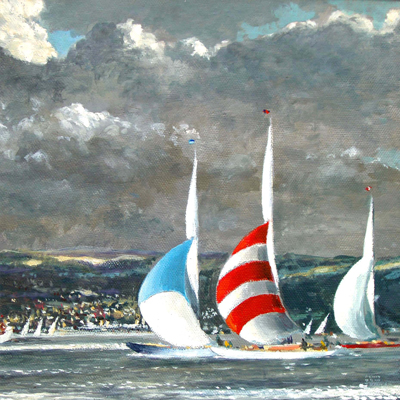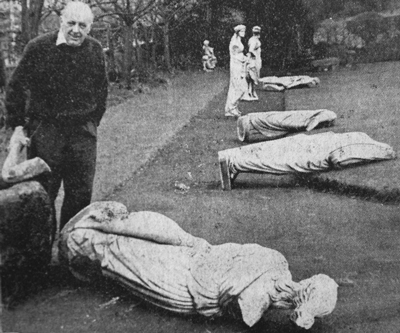A KILCREGGAN man made his living from breaking up ships — but he also had a special talent for preserving nautical subjects by painting them.
'Clyde Regatta' is one of Arthur Henry Turner's paintings, and it is owned by the Anderson Trust Local Collection and is often exhibited in Helensburgh Library.
Not the most prominent of the paintings the Trust displays, it is nevertheless one of the best loved, judging by the number of people who are keen to buy the card reproductions which the Trust has produced.
Its popularity is not hard to explain — the yachts in full sail, revelling in a trusty Clyde wind, is enough to gladden the heart of the many sailors in the area.
The fact that the artist succeeds in capturing not only the familiar scene itself but the carefree joy of movement that inspires it makes this painting one that never loses its appeal.
What may interest admirers of this painting even more, and encourage local amateur painters, is that the artist had no formal art training.
Arthur Turner, who was born in England in 1901, was a successful Glasgow shipbroker who moved to Aidengrove, Argyll Road, Kilcreggan in 1929. Surrounded by ships in his working day, he was happy to relax in his peninsula home with paintbrush or pencil and to surround himself with pictures of boats.
His origins, too, in landlocked Gloucestershire, seem an unlikely source of inspiration for someone who grew up to be such an accomplished painter of boats and the sea. But boats and the sea were to become both his career and his personal passion.
Having rebelled against his parents’ wishes that he follow in his father’s career as a railway station master, Arthur served his time with shipping firms in Cardiff, Liverpool and London before establishing his own shipping firm in Glasgow in 1930, by which time he had already had paintings hung in the Royal Scottish Academy.
Turner and Hickman Ltd. specialised for many years in buying and salvaging ships for breaking up in the Faslane shipbreaking yards, including famous ships such as the Cunard White Star liner Aquitania and some of the 'doon the watter' pleasure steamers – the Jeanie Deans and the Duchess of Montrose.
By happy coincidence, a fine painting by R.H.Wylie of one of the last of the Clyde pleasure steamers, the Lucy Ashton, is also owned by the Anderson Trust.
One of his proudest moments came in 1950 when he watched from his home the four-funnelled liner Aquitania sail into the Clyde, as at that point he owned the liner in the interval between the ship coming off service and going to the Shipbreaking Industries yard at Faslane.
He was responsible for the safe towage of three destroyers from Canada to the Faslane yard, and also delivered the battleship King George V to shipbreakers at Dalmuir.
He also played a part in the setting up of the pirate radio station Radio Scotland, as he advised Tommy Shields, who headed the radio company, on the most suitable type of ship for broadcasting the popular music programmes, offshore.
 One could claim that Arthur Turner’s painting career began well before his career in shipping, with his parents’ gift to him, at the age of seven, of a box of watercolours.
One could claim that Arthur Turner’s painting career began well before his career in shipping, with his parents’ gift to him, at the age of seven, of a box of watercolours.
But he never considered painting as a career though, for most of his life, he was rarely without pen or paint and would use every opportunity to create visual records of his experiences and interests.
As early as 1923, when he was still very young, his detailed pen and ink drawings were used by a Liverpool publisher as illustrations for a book on tugs, and he was complimented for “giving variety and a sense of life and personality” to the vessels he was drawing.
During and after World War Two, he worked for the Ministry of Supply as director of the British Iron & Steel Corporation, responsible for the recovery and ultimate breaking up of war damaged vessels.
His special responsibility during the war was acquiring steel to meet Britain's shipping needs, which involved him in the salvaging of ships which had sunk.
He spent some time in Malta reclaiming steel from sunken vessels, then was involved in clearance operations on the Normandy beaches soon after the invasion. But he still found time to make visual notes and later planned to publish this collection of sketches.
Arthur, a Fellow of the Chartered Institute of Shipbrokers, surrounded himself in both his home and his working environment with beautiful ship models and marine paintings, but the abiding source of inspiration for him came from the sea itself, and he ensured that it was always within view.
He built himself a studio in his house in Kilcreggan which looked out over the pier and the Firth of Clyde, and, in his later years, he was able to indulge his passion for painting ships and the ever changing moods of sea and sky.
Though friends and discerning art lovers appreciated the natural talent in this self-taught artist, Arthur Turner continued to paint purely for his own enjoyment and remained unassuming and uncompetitive about the results.
He did not exhibit in galleries, but preferred to give his paintings away to friends and family.
It appears that his artistic talent has been inherited by his son Harry and grandson Marc, both of whom became professional photographers.
Thirty years after Arthur Turner’s death in 1970 at the age of 70, his son and grandson traced and displayed over forty of his paintings for an exhibition mounted in the appropriately nautical setting of the SV Glenlee in Glasgow Harbour.
Setting up the exhibition was an emotional experience for them, which brought them in contact with paintings and grateful recipients whom they barely knew, and revealed hidden aspects of a man who was better known as “the man who scrapped 1,000 ships” than as an artist.
 ■ He and his wife Katalina, known as Kay, had another special interest.
■ He and his wife Katalina, known as Kay, had another special interest.
In their sloping landscaped garden they had an extensive collection of stones and statues, spotted on their many travels and brought to their home. Some dated back to ancient Greece.
An article in the Helensburgh Advertiser, published in the late 1960s, noted that the garden contained many ancient and interesting stone relics, and continued: “These have been worked in to blend beautifully in the general layout of their house and its surroundings.
“Only last week Mr Turner acquired another fine specimen for his unique collection. The demolition of part of Glasgow's Rotten Row, near where the university once stood, brought to light a beautifully carved 17th century stone which will soon be preserved for posterity in his garden."
One of his saddest moments came in 1964 when he discovered that vandals had attacked this collection, knocking over and attempting to smash eight of the statues — each weighing over half a ton.
What happened to the stone collection and what else it contained is not known. If any reader can help, please email the Heritage Trust
Mrs Turner was born in Bootle and lived in Dalmuir for a time before the couple moved to the peninsula in the early 1930s. She founded the local branch of the British Sailors Society Guild in 1953, she embroidered for church funds, and she was a member of Cove and Kilcreggan Drama Group for over 20 years, acting in some of their productions.
She was an active member of the now disbanded Peninsula Electro-Cardiogram Committee which raised money for and purchased an electro-cardiogram and other medical equipment for Kilcreggan Health Centre. She died in her sleep at her home at the age of 65, a year after her husband.




